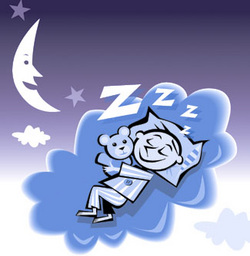Phases of Sleep
When you sleep, your body rests and restores its energy levels. Sleep is an active state that has an affect on both your physical and mental well-being. A good night's sleep is often the best way to help you cope with stress, solve problems, or recover from illness. Sleep is prompted by natural cycles of activity in the brain and consists of two basic states: rapid eye movement sleep and non-rapid eye movement sleep, which consists of Stages 1 through 4. Typically, people begin the sleep cycle with a period of non-REM sleep followed by a very short period of REM sleep. Dreams generally occur in the REM stage of sleep.
The period of NREM sleep is made up of stages 1-4. Each stage can last from 5 to 15 minutes. A completed cycle of sleep consists of a progression from stages 1-4 before REM sleep is attained, then the cycle starts over again.
During Stage 1, the eyes are closed. This is when we might address someone as a "light sleeper." This stage typically lasts for about five to ten minutes. One can notice the relaxing feeling of falling asleep.
Stage 2 is a period of light sleep as well. The heart rate slows and the body temperature decreases. At this point, the body now prepares to enter what is known as deep sleep.
Stages 3 and 4 are deep sleep stages. Stage 4 is the more intense stage. If awoken from sleep during this stage, a person might, for a few minutes, feel disoriented.
During the deep stages of NREM sleep, the body repairs and regenerates tissues, builds bone and muscle, and appears to strengthen the immune system. As you get older, you sleep more lightly and get less deep sleep. Aging is also associated with shorter time spans of sleep, although studies show the amount of sleep needed doesn't appear to diminish with age.
Work Cited
The period of NREM sleep is made up of stages 1-4. Each stage can last from 5 to 15 minutes. A completed cycle of sleep consists of a progression from stages 1-4 before REM sleep is attained, then the cycle starts over again.
During Stage 1, the eyes are closed. This is when we might address someone as a "light sleeper." This stage typically lasts for about five to ten minutes. One can notice the relaxing feeling of falling asleep.
Stage 2 is a period of light sleep as well. The heart rate slows and the body temperature decreases. At this point, the body now prepares to enter what is known as deep sleep.
Stages 3 and 4 are deep sleep stages. Stage 4 is the more intense stage. If awoken from sleep during this stage, a person might, for a few minutes, feel disoriented.
During the deep stages of NREM sleep, the body repairs and regenerates tissues, builds bone and muscle, and appears to strengthen the immune system. As you get older, you sleep more lightly and get less deep sleep. Aging is also associated with shorter time spans of sleep, although studies show the amount of sleep needed doesn't appear to diminish with age.
Work Cited

